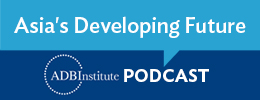Archive | Information and Communications Technology RSS feed for this section
Governance and public sector management, Information and Communications Technology
 Governance and public sector management, Information and Communications Technology
Governance and public sector management, Information and Communications Technology
 Economics, Finance sector development, Industry and trade, Information and Communications Technology
Economics, Finance sector development, Industry and trade, Information and Communications Technology
 Economics, Environment, Information and Communications Technology, Infrastructure, Social development and protection, Urban development
Economics, Environment, Information and Communications Technology, Infrastructure, Social development and protection, Urban development
 Governance and public sector management, Information and Communications Technology
Governance and public sector management, Information and Communications Technology
 Economics, Finance sector development, Information and Communications Technology
Economics, Finance sector development, Information and Communications Technology
 Economics, Finance sector development, Information and Communications Technology
Economics, Finance sector development, Information and Communications Technology
 Governance and public sector management, Industry and trade, Information and Communications Technology, Private sector development
Governance and public sector management, Industry and trade, Information and Communications Technology, Private sector development
 Finance sector development, Information and Communications Technology
Finance sector development, Information and Communications Technology
 Education, Information and Communications Technology
Education, Information and Communications Technology

Digital governance can unlock connectivity potential and transformation

Digital governance incorporates new norms, rules, and processes to achieve efficiency and effectiveness in government functions for all stakeholders.
Artificial intelligence to unlock sustainable development potential in Southeast Asia

Emerging artificial intelligence technology has the potential to accelerate Southeast Asia's lagging progress toward the Sustainable Development Goals.
Harnessing digitalization on the path to sustainable economic development in Asia

Digitalization is helping to transform economies by enhancing economy-wide competitiveness and productivity, with trade being an important channel. The use of big data and the emergence of online platforms have further bolstered the progression of the digital economy, particularly in Asia.
Levelling up innovation in Asia

Innovation is playing a vital role in the economic, social, and environmental progress of Asia and the Pacific and has been an important factor in the region's rapid and successful transformation. However, many countries in the region lag behind, innovating at a fraction of the pace as countries in similar or even lower income groups.
Taxation and digitalization in the COVID-19 era

The coronavirus disease (COVID-19) pandemic has created challenges for tax administrations and is constraining tax revenue in many countries. Its impacts have caused the global economy to slow down, leading to reduced tax collection. However, the pandemic has also changed social habits and encouraged people to use digital technologies.
Fintech development transforming the financial landscape in the People’s Republic of China

Financial technology (fintech) is rapidly changing the financial landscape in the People’s Republic of China (PRC), with important implications for financial inclusion and macroeconomic stability (Huang 2020). Fintech in the PRC started at the end of 2004 when the mobile payment service Alipay first came online. However, fintech did not grow dramatically until 2013, when the online money market fund Yu’ebao started to receive investments from Alipay users.
Digital transformation poses potential risks for stability and the financial industry

Digital transformation is changing how and by whom financial services are provided, bringing benefits to consumers in the form of expanded and simplified access to financial services. However, this transformation is also affecting the financial services industry in ways that could lead to greater risks to systemic financial stability.
The value creation potential of platforms

The rapid success of modern platforms is a testament to their ability to scale efficiently to the needs of many while providing an undeniable and significant advantage over the older methods that had so far dominated value exchanges. Powered by the public Internet and robust local connectivity, digital platforms rose to the challenge of developing newer, more efficient alternatives in their respective focus areas.
Closing the gender gap in peer-to-peer lending

Financial inclusion for women has been embraced by policy makers as an important development priority. However, despite women having lower risk preferences and higher creditworthiness, the gender gap in access to finance is still prevalent in the traditional credit market. This is due to various factors, such as differences in employment opportunities, legal obstacles, cultural norms, and limited access to the guarantee mechanism, among others.
E-learning to enhance capacities in Asia and the Pacific

The digital age poses both challenges and opportunities for many developing countries in Asia and the Pacific. In recent years, we have seen jobs in various sectors become obsolete. At the same time, we see new economic spaces being created demanding new skills and competencies. This also necessitates finding innovative ways to facilitate learning and to promote knowledge sharing, especially in the context of economic development.


Search
Subscribe / Connect to Asia Pathways
Subjects
- Agriculture and natural resources
- Blog
- Capacity development
- Climate change
- Economics
- Education
- Energy
- Environment
- Finance sector development
- Gender
- Governance and public sector management
- Health
- Industry and trade
- Information and Communications Technology
- Infrastructure
- Miscellaneous
- Population
- Poverty
- Private sector development
- Regional cooperation and integration
- Sanitation
- Social development and protection
- Transport
- Uncategorized
- Urban development
- Video Blog
- Water
Recent Posts
- Transforming ASEAN: Advancing Regional Integration, Social Inclusion, and Environmental Sustainability
- Development of the Creative Economy in Asia and the Pacific
- Kashima City’s Great Transformation: Where Industry Meets Community
- Mechanization Driving the Future of Agriculture in Asia
- Natural Capital: Valuing Nature to Protect and Restore Ecosystem Services for Sustainable Development




Recent Comments